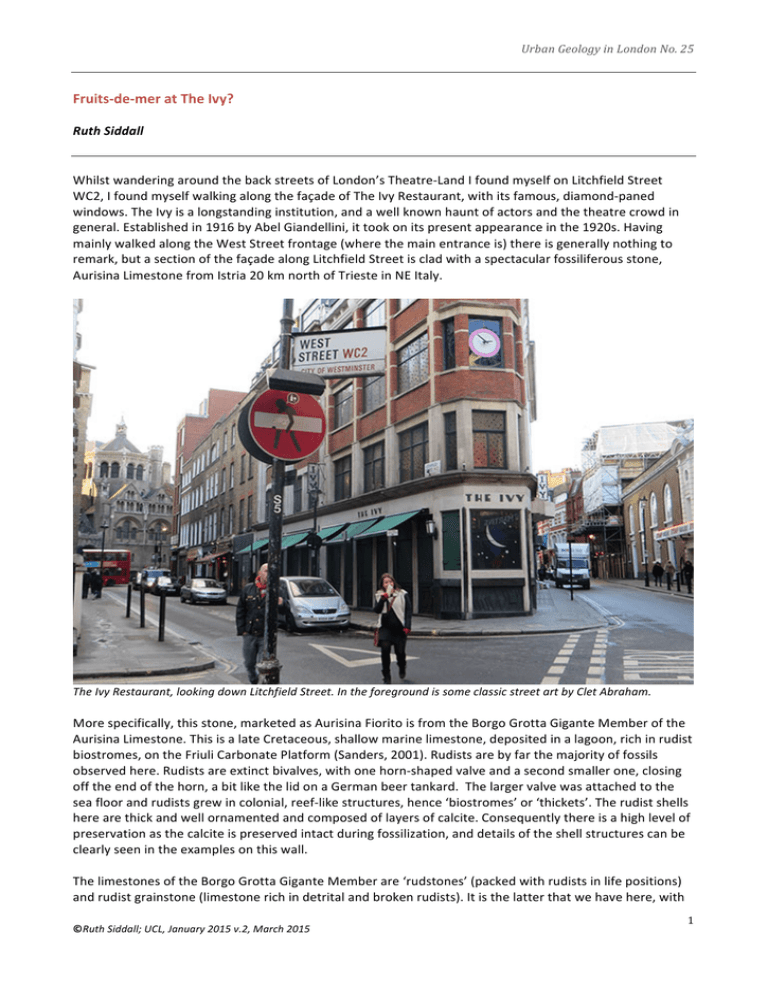Document 12425233
advertisement

Urban Geology in London No. 25 Fruits-­‐de-­‐mer at The Ivy? Ruth Siddall Whilst wandering around the back streets of London’s Theatre-­‐Land I found myself on Litchfield Street WC2, I found myself walking along the façade of The Ivy Restaurant, with its famous, diamond-­‐paned windows. The Ivy is a longstanding institution, and a well known haunt of actors and the theatre crowd in general. Established in 1916 by Abel Giandellini, it took on its present appearance in the 1920s. Having mainly walked along the West Street frontage (where the main entrance is) there is generally nothing to remark, but a section of the façade along Litchfield Street is clad with a spectacular fossiliferous stone, Aurisina Limestone from Istria 20 km north of Trieste in NE Italy. The Ivy Restaurant, looking down Litchfield Street. In the foreground is some classic street art by Clet Abraham. More specifically, this stone, marketed as Aurisina Fiorito is from the Borgo Grotta Gigante Member of the Aurisina Limestone. This is a late Cretaceous, shallow marine limestone, deposited in a lagoon, rich in rudist biostromes, on the Friuli Carbonate Platform (Sanders, 2001). Rudists are by far the majority of fossils observed here. Rudists are extinct bivalves, with one horn-­‐shaped valve and a second smaller one, closing off the end of the horn, a bit like the lid on a German beer tankard. The larger valve was attached to the sea floor and rudists grew in colonial, reef-­‐like structures, hence ‘biostromes’ or ‘thickets’. The rudist shells here are thick and well ornamented and composed of layers of calcite. Consequently there is a high level of preservation as the calcite is preserved intact during fossilization, and details of the shell structures can be clearly seen in the examples on this wall. The limestones of the Borgo Grotta Gigante Member are ‘rudstones’ (packed with rudists in life positions) and rudist grainstone (limestone rich in detrital and broken rudists). It is the latter that we have here, with ©Ruth Siddall; UCL, January 2015 v.2, March 2015 1 Urban Geology in London No. 25 grey-­‐brown fossils in a pale ivory-­‐cream, fine grained limestone. Longitudinal and cross-­‐sections of the shells are visible. These can be seen as sub-­‐circular sections with spines or flanges protruding outwards. The species present in the Aurisina limestones are Hippurites nabresinensis and Radiolites sp. Other shell debris (composed of forams, echinoids, sponges, gastropods, bryozoa and so on) and bioturbation (Thalassinoides) are present (below). The Friuli Carbonate Platforms were an archipelago of Cretaceous shallow-­‐marine shelves located in the peri-­‐Adriatic sea. These were exposed in the latest Cretaceous-­‐Paleogene, (allowing for the preservation of the rudist ‘thickets’) and subsequently became part of the Adriatic Alpine foredeep, where they were covered in flysch and then thrusted to the SW, finding their present location, during Alpine collision. Left; a geological map of the Trieste area and the Aurisina Limestone, in the Italian province of Friuli – Venezia Giulia, on the NE coast of the Adriatic Sea (from Maritan et al., 2003). The stone has been quarried from the Cava Romana, near the town of Aurisina since at least the 1st Century AD and was used by the Romans in a number of structures, including the Arena in the nearby town of Pula (Crnkovic, 1991) and for tomb monuments in Udine (Aquileia; Maritan et al., 2003) as well as a number of buildings in Milan and Lombardy (see Bugini & Folli, 2014). Three varieties of decorative and dimension stone continue to be extracted today from the Borgo Grotta Gigante Member today and sold under the names of Aurisina Fiorito (or Fiorita) with deformed rudist shells; Another variety is Aurisina Granitello, a packstone with coarse shell fragments. Roman Stone or Nabresina has finer shell fragments (Bugini & Folli, 2014). Rudists died out during the end-­‐Cretaceous mass extinction event. Unfortunately, we will never know how much meat there was on a rudist and how tasty they were, but I expect many would make a substantial meal. However, I would like to think that their large aductor muscles would have been similar to scallops, ©Ruth Siddall; UCL, January 2015 v.2, March 2015 2 Urban Geology in London No. 25 and they would have tasted lovely fried in garlic butter with a bit of samphire on the side. I’m sure that the head chef at The Ivy could rustle up something delicious with them. Cava Romana, Aurisina in 2009 (image: http://it.wikipedia.org/wiki/File:Aurisina_09.jpg). Section through a spiny rudist. Also note the unstructured, bioturbated matrix, packed with fine shell fragments. ©Ruth Siddall; UCL, January 2015 v.2, March 2015 3 Urban Geology in London No. 25 Continuing around to the West Street façade of the restaurant, there are more marine morsels to be found. First of all though, we pass the doorway which has a surround of beautiful, deep green Lake District Slate. This is one of the so-­‐called ornamental tuffs of Cumbria, quarried from the Seathwaite Fell Formation (Millward et al., 2000) of the Borrowdale Volcanic Group at various localities including Elterwater and Broughton Moor Quarries. These are Ordovician pyroclastic deposits which were reworked in a caldera lake environment (See Patterson et al., 1992). On the soffit of the right hand side of the doorway (going in), there is a rip-­‐up clast of fine grained ash incorporated into this gritty, lapilli-­‐rich tuff. Above left; entrance to The Ivy on west Street. Right; Lake District Green Slate with a rip-­‐up clast of fine grained ash. Walking further along West Street, the next entrance is The Club at the Ivy. Here another spectacularly fossiliferous stone is used; a nummulite-­‐rich calcarenite. Here slices through large nummulites, which would in three dimensions formed discs around 3 cm in diameter are seen in abundance scattered through this stone. They are in a matrix of fossil fragments, carbonate material and the greenish mineral Glauconite (below). The origin of this stone cannot be confirmed but it is identical to a Turkish limestone marketed as ‘Rustic Green’ which is quarried near the Town of Safranbolu in the Karabük Province of northern Turkey. Rustic Green is Lower Lutetian (Eocene) in age and belongs, stratigraphically to the Küpler Formation of the Karabük Group. These are shallow marine, carbonate basin deposits which were carried westwards, piggy-­‐ ©Ruth Siddall; UCL, January 2015 v.2, March 2015 4 Urban Geology in London No. 25 back style on a thrust fault during the Upper Lutetian (Kocyigit, 1987). Here the large nummulites are identified as Assilina exponens and Kocyigit (1987) also records the presence of Nummulites uroniensis, Alveolina sp., Orbitolites sp., Cuvillerina sp. and gastropod fragments. Above; Assilina exponens fragments seen at The Club at The Ivy. References Bugini, R. & Folli, L., 2014, The use of Aurisina Limestone in the Roman architecture (Milan and Lombardy)., VIII Congresso Nazionale di Archeometria Scienze e Beni Culturali: stato dell’arte e prospettive Bologna 5 -­‐ 7 Febbraio 2014., 3 pp. Crnkovic, B., 1991, The origin of the dimension stone of the arena in Pula., Rudarsko-­‐geoloSko-­‐naftni zbornik., 3. 63-­‐67. Kocyigit, A., 1987, Stratigraphy and nature of the northern margin of the Karabuk-­‐Safranbolu Tertiary basin, Turkey., Bulletin of the Geological Society of Turkey., 30, 61-­‐69. Maritan, L., Mazzoli, C. & Melis, E., 2003, A multidisciplinary approach to the characterization of Roman gravestones from Aqulieia (Udine, Italy)., Archaeometry., 45, 3, 363–374. Millward D, et al. 2000. Geology of the Ambleside district. Memoir of the British Geological Survey, Sheet 38 (England and Wales). Petterson, M G, Beddoe-­‐Stephens, B, Millward, D and Johnson, E W, 1992. A pre-­‐caldera plateau-­‐ andesite field in the Borrowdale Volcanic Group of the English Lake District. Journal of the Geological Society, London, Vol. 149, 889-­‐906. Sanders, D., 2001, Burrow-­‐mediated carbonate dissolution in rudist biostromes (Aurisina, Italy): implications for taphonomy in tropical, shallow, subtidal, carbonate environments., Palaeogeography, Palaeoclimatology & Palaeoecology, 168, 39-­‐74. The Ivy is located at 1-­‐5 West St, London WC2H 9NQ; http://www.the-­‐ivy.co.uk ©Ruth Siddall; UCL, January 2015 v.2, March 2015 5 Urban Geology in London No. 25 Longitudinal and cross-­‐sections through rudists in the Aurisina Limestone variety Aurisina Fiorito. Above Nummulitic Limestone at The Club at the Ivy. Field of view is 12 cm. How to cite this article: Siddall, R, 2015, Fruits-­‐de-­‐mer at The Ivy?, Urban Geology in London No. 25, http://www.ucl.ac.uk/~ucfbrxs/Homepage/walks/Ivy.pdf ©Dr Ruth Siddall, University College London, Gower Street, London WC1E 6BT, UK: r.siddall@ucl.ac.uk Downloads from http://www.ucl.ac.uk/~ucfbrxs/Homepage/UrbanGeology.htm; Facebook | Cultural & Urban Geology | Twitter:@R_Siddall | #UrbanGeology ©Ruth Siddall; UCL, January 2015 v.2, March 2015 6



